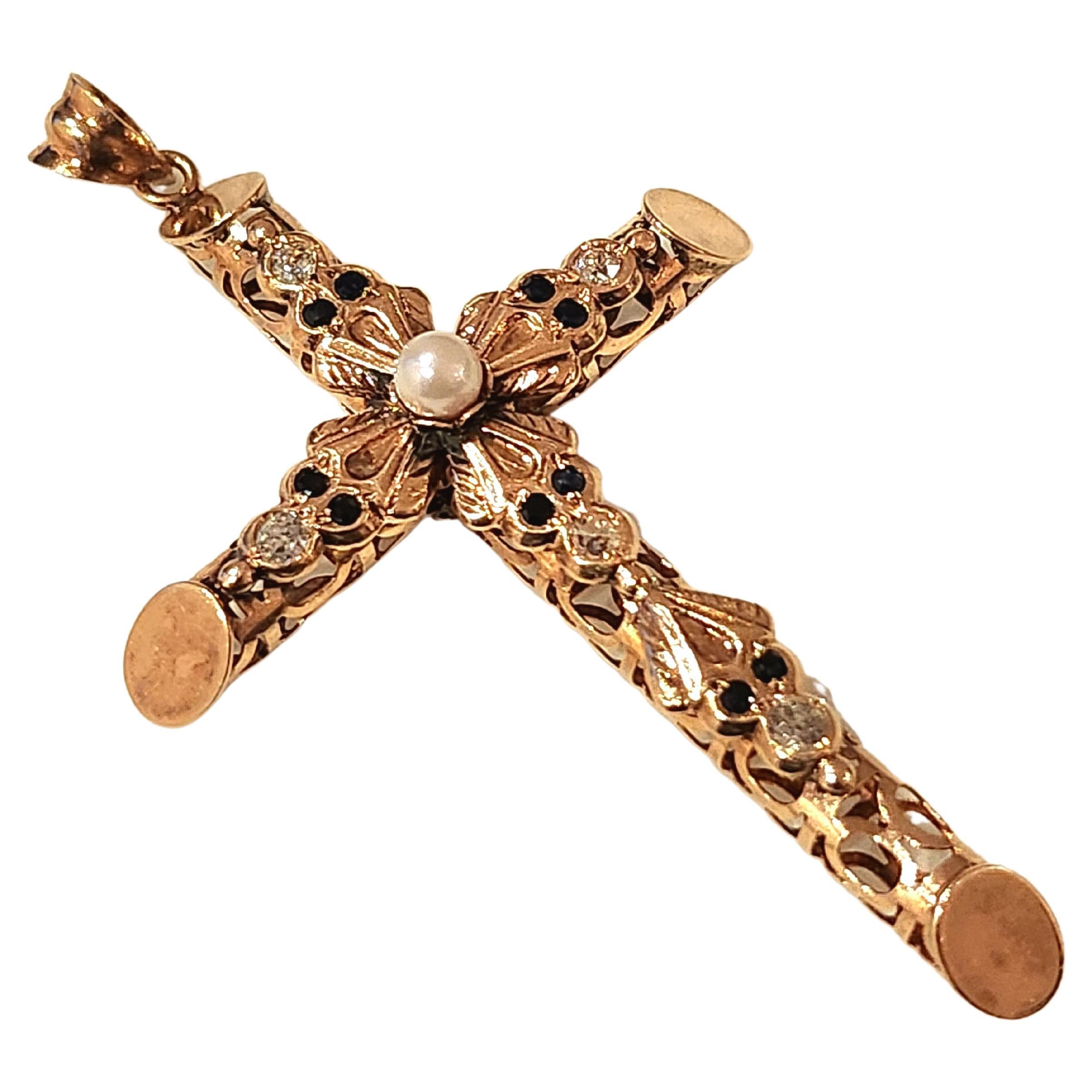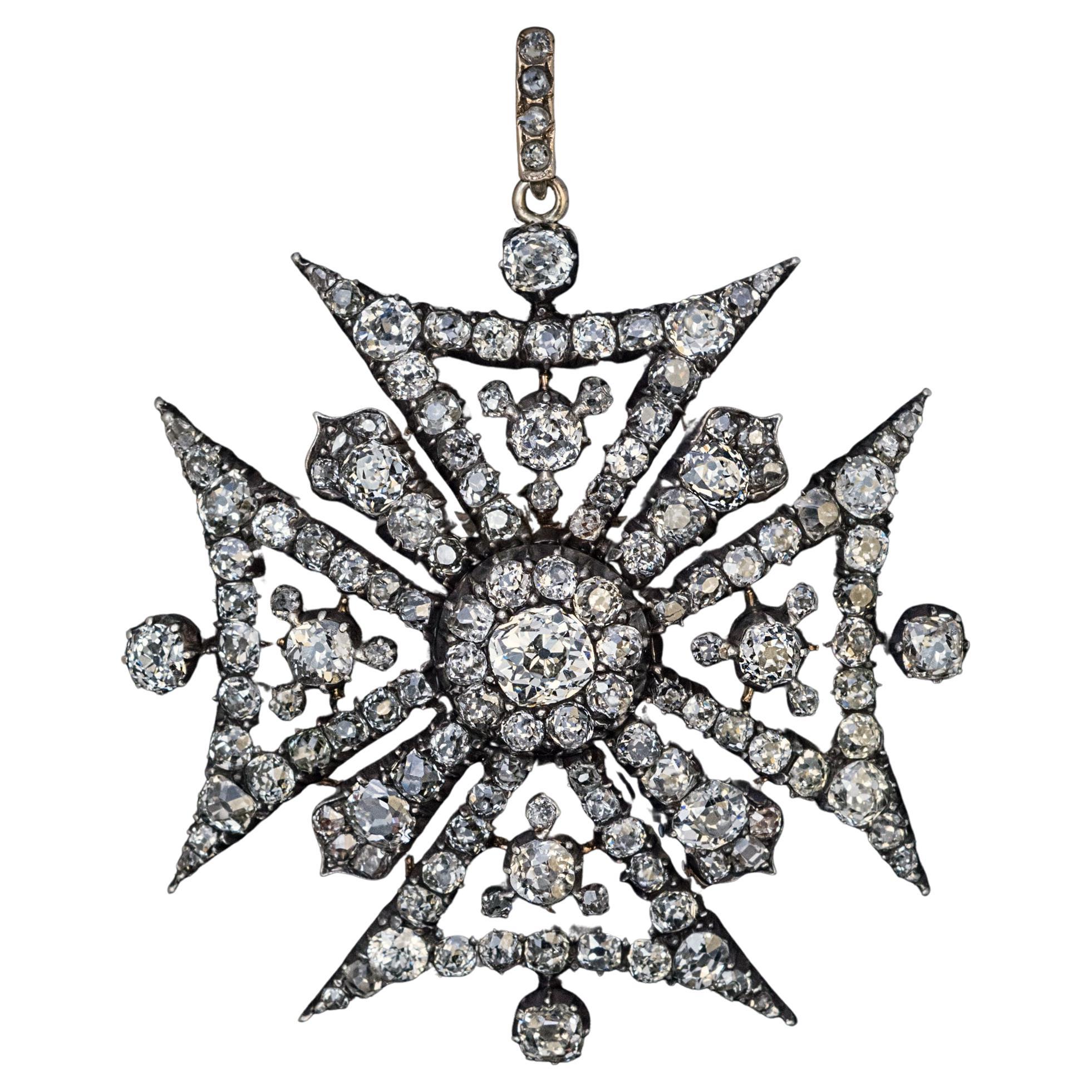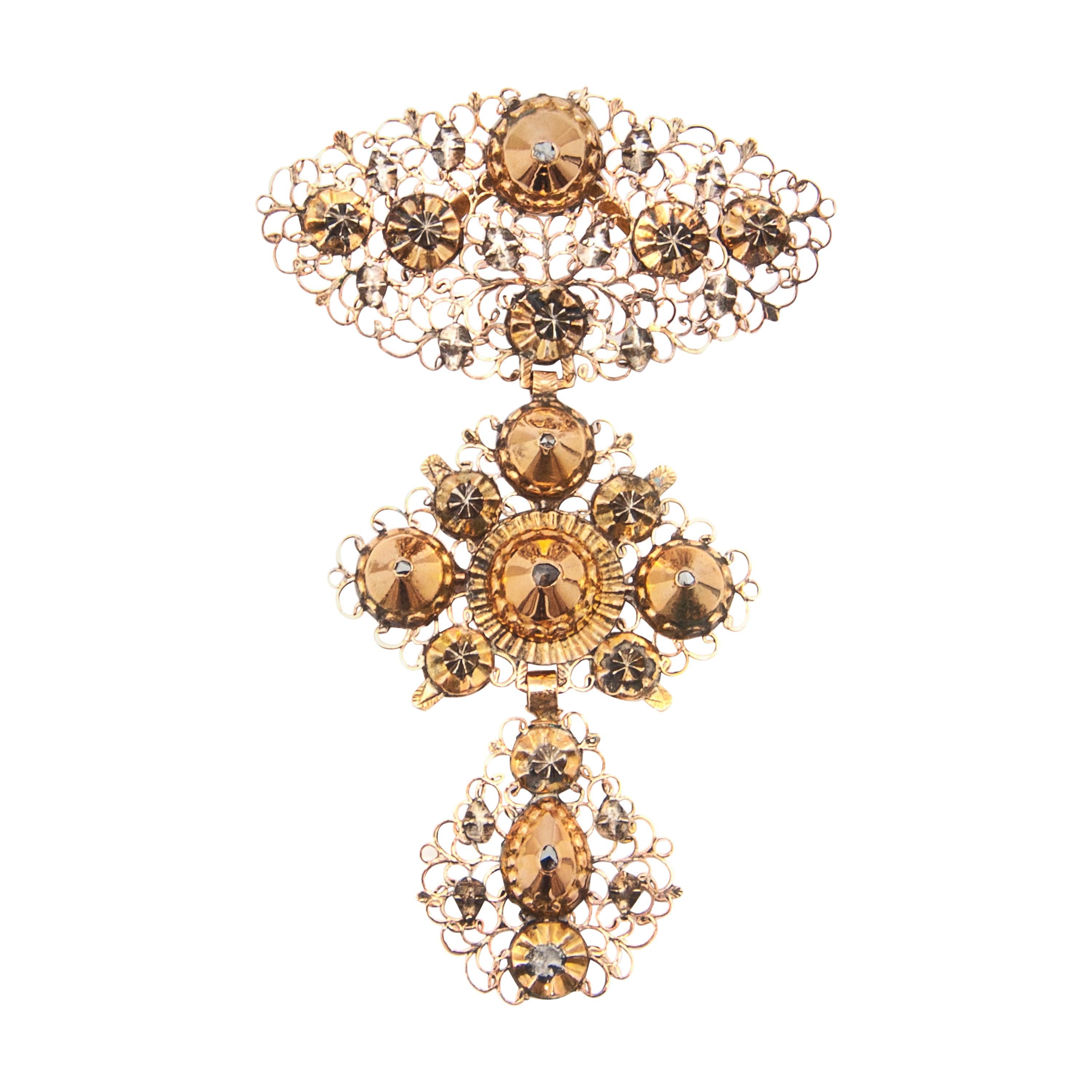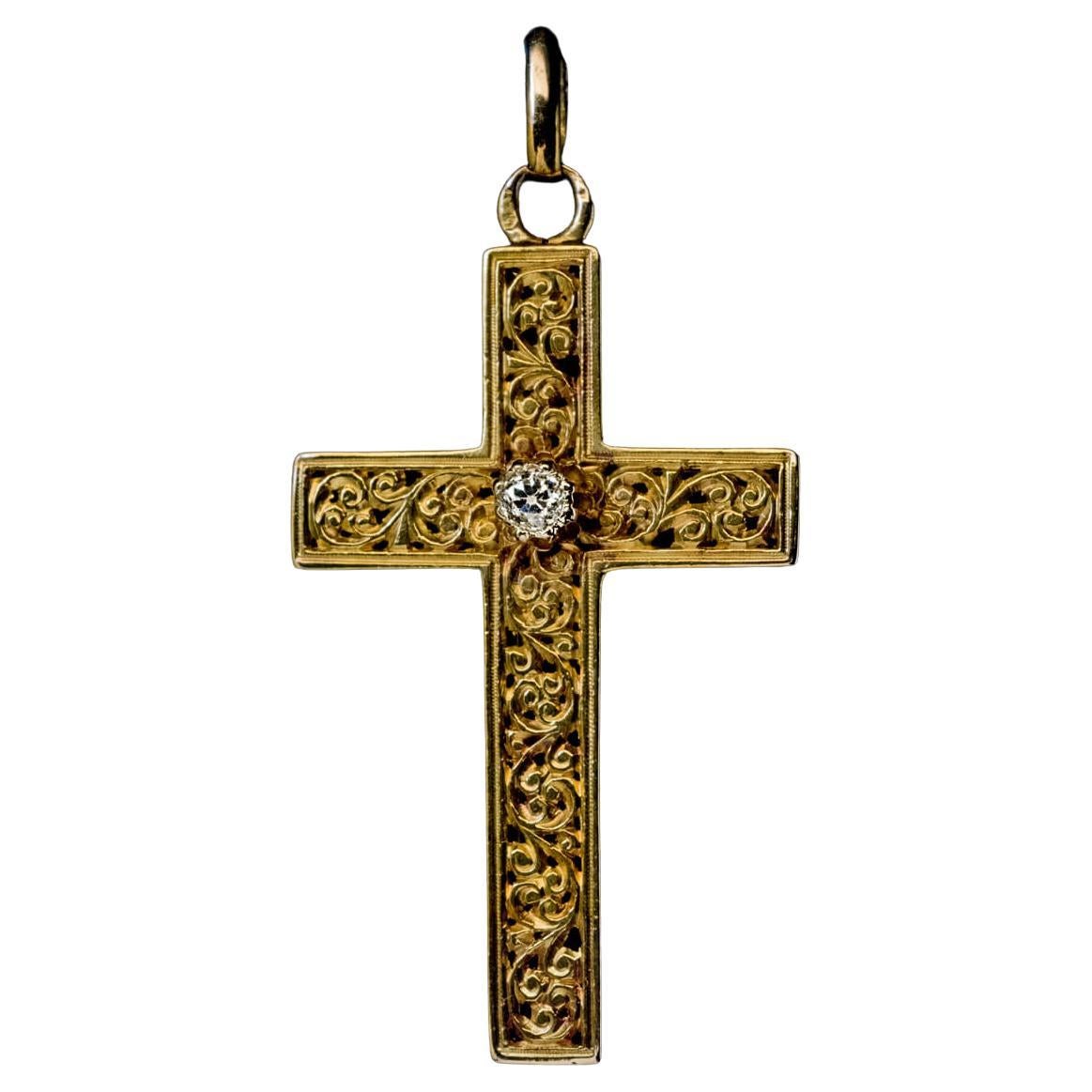Want more images or videos?
Request additional images or videos from the seller
Antique diamond cross
About the Item
Edwardian diamond cross.
Measures 6.5 x 4.2cm.
Center stone is approx. 0.5ct rest approx. 3ct in
Diamond weight in total approximately 3.50ct H-I, vs-si
Gross weight: 9.8 grams
A resonating statement, be of faith or fashion, or indeed both. Religious symbols have always been present in jewelry. Because of its religious significance but equally as a fashion statement, the cross is common motif. No matter if it is a classic, simple, small crucifix, bearing the body of Christ; perhaps made of non-precious metal, or an elaborate confection of gems and gold maybe less an aid to prayer than a bold (fashion) testament to the jeweled arts.
In 2023 Kim Kardashian famously bought an amethyst and diamond pendant that the Princess of Wales, Diana, wore repeatedly in the late 1980s. Rihanna wore a 1980s Christian Lacroix cross in the photo reveal of her first pregnancy in 2022. The cross has received more high-profile, high-fashion visibility than any time since the 1990s and early 00, when women like Drew Barrymore and Cindy Crawford regularly wore crosses.
It seems Madonna’s “Like a Virgin” look circa 1984 is here. Lourdes Leon, daughter of Madonna, wore a similar cross to ours to the Grammys 2023.
It’s romantic, ethereal and timeless. It’s neither masculine nor feminine.
A cross has a deeply rooted meaning and place in our consciousness, which predates what modern history has assigned to it.
For some people, it can mean redemption from suffering. It can represent the passion of the son of God and of God’s great unmerited love for us. To non-believers, it can mean the four directions. It can represent elements of fire, water, earth and air. It’s a symbol that resonates on a global plane.
Or you can just wear it cause you think it is beautiful, dramatic and cool and a piece of (jewelry) history.
- Metal:
- Stone:
- Stone Cut:
- Weight:9.8 g
- Dimensions:Width: 1.58 in (40 mm)Length: 2.56 in (65 mm)
- Style:
- Place of Origin:
- Period:
- Date of Manufacture:1910
- Condition:Wear consistent with age and use.
- Seller Location:Malmö, SE
- Reference Number:1stDibs: LU3148222558822

About the Seller
5.0
Recognized Seller
These prestigious sellers are industry leaders and represent the highest echelon for item quality and design.
Platinum Seller
These expertly vetted sellers are 1stDibs' most experienced sellers and are rated highest by our customers.
Established in 2015
1stDibs seller since 2022
31 sales on 1stDibs
Typical response time: <1 hour
- ShippingRetrieving quote...Ships From: Malmö, Sweden
- Return PolicyA return for this item may be initiated within 3 days of delivery.
More From This SellerView All
- Antique victorian yellow gold collar necklaceLocated in Malmö, SEA special and very modernistic design for a Victorian piece! Antique collar necklace in yellow 14 karat gold. Unmarked, lenght of necklace 39.0cm, weight 25.3 gramCategory
Early 20th Century English Late Victorian Pendant Necklaces
MaterialsGold, Yellow Gold, 14k Gold
- Art Deco aquamarine, diamond and onyx pendant necklaceLocated in Malmö, SEImmerse yourself in our drop of seawater. Aquamarine & Diamond and onyx pendant. Height of Aqua approx 2,5cm / 1 inch, 13mm / 0.05 inch wide. Total length of pendant 4 cm / 1,57 i...Category
Early 20th Century European Art Deco Drop Necklaces
MaterialsAquamarine, Diamond, Onyx
- Cartier ‘Délices de Goa’ pendant decorated with turquoises, amethysts & diamondsBy CartierLocated in Malmö, SECartier ‘Délices de Goa' pendant decorated with turquoises and amethysts three of which are enriched with brilliant cut diamonds. The Cartier's...Category
Early 2000s French Modern Pendant Necklaces
MaterialsAmethyst, Diamond, Turquoise, 18k Gold, Yellow Gold
- Antique old world belle époque emerald and diamond braceletLocated in Malmö, SEAntique old world Belle époque emerald bracelet, Alluring and mesmerizing darkened silver accentuated by lush deep green emeralds. An elegant e...Category
Antique Late 19th Century European Link Bracelets
MaterialsDiamond, Emerald, Gold, 14k Gold, Silver
- 19th Century Pendant Featuring an 45ct Amethyst under a Sapphire CrownLocated in Malmö, SEAn impressive 45 carat oval faceted and deeply saturated amethyst gracefully set framed in a scrolling foliate under a sapphire crown and embellished by...Category
Antique Late 19th Century European Renaissance Revival Pendant Necklaces
MaterialsSapphire, Ruby, Oriental Pearl, Emerald, Amethyst, Silver, 14k Gold, Gold
- 1937 Art Deco 85 carat rock crystal silver necklace by Wiwen NilssonBy Wiwen NilssonLocated in Malmö, SESilver and approx 85ct rock crystal. Signed and dated 1937. The pendant is 6,7 cm long on a 59 cm long chain. Wiwen Nilsson (1897-1974) - An Art Deco Silversmith in the Age of Modernism. Wiwen Nilsson was born in Copenhagen, Denmark in 1897. Born as Karl Edvin, but since he did not like his christening name, he was, within the family, called Wiwen. He was the son of Karolina and Anders and grew up with his sister Edith. In 1897 the family moves to Lund, Sweden when the father takes over the gold and silversmith company J.P. Hasselgren & Son. In 1906, Wiwen began at Katedralsskolan in Lund and finished school when he graduated fifth grade in 1912. It was common to continue up to sixth grade and then high school, but Wiwen who does not thrive in a school environment wants to become a pianist or aviator instead. However, as the father is a recognized jeweler and court supplier, the son's career is already marked. Instead, he embarks on an educational journey with the goal Königliche Zeichenakademie in Hanau am Main, Germany. The school is Germany's oldest and most prestigious goldsmith's school. Wiwen enrolled on the fourth of August in 1913 and studied drawing, workshop work, engraving and hammering work. The education comes to an abrupt end with the outbreak of the First World War in 1914, and he instead continues his education in his father's workshop, where he stays until 1919. He does, however, make two breaks, the first quarter of 1917 he enrolled at the Technical Society's School in Copenhagen where he studied modeling, among other things, and in 1917-1918 he did his military service in Stockholm. In 1919 he applied for and received his companion letter, at the same time he received the Swedish Craft Organization's large medal in silver for his professionalism. In 1920 he is again at the school in Hanau, Germany where he stays until 1921 and practices with the jewelry company Chr. Kissling also in Hanau. At school, he mainly studies drawing and chiseling, a type of relief technique that was very popular during the 17th century. Wiwen is driven by his own design language and thinks that the prevailing technique under the influence of Danish designers is a setback in the development of chiseling. During his time in Hanau, he visits several arts and craft exhibitions and comes into contact with the Wiener Werkstätte and the Wiener Werkbund, among others. At the same time as he is studying, he writes travel stories where it emerges that he believes that Sweden's conservatism inhibits the development of arts and crafts, something he himself wants to change. Back in Sweden in 1921, he was appointed the company's artistic designer. In 1923, the company participates in the Gothenburg exhibition, but here Wiwen receives devastating criticism. His creations are considered ugly and meaningless, a critic writes that it is a typical case of poor material sense. In 1924, Wiwen Nilsson travels to Paris. Just like in Hanau, he studies chiseling, silver, drawing and modeling at the Académie de la Grande Chaumiére (now Académie Charpentier). One of France's foremost art schools where, among others, Siri Derkert (1888-1973) and Bror Hjorth (1894-1968) have also studied. In Paris he became acquainted with Georg Jensen (1866-1935), in whose workshop he chiseled for a period. He also meets and hangs out frequently with Jules Schyl (1893-1977) and Gösta Adrian-Nilsson, GAN (1884-1965). The meeting with GAN becomes extremely important and came to influence and refine Wiwen's own design language and together they hold a joint exhibition in 1925 in Lund. From 1925 until the end of the 1920s, Wiwen Nilsson produces a large amount of church silver. He designs and manufactures for, among others, Allhelgonakyrkan in Lund, Knästorps and Tottarps kyrka in Skåne. In total, Wiwen's workshop manufactures 677 objects for churches, of which 483 are found in churches within the diocese of Lund and 194 in other Swedish churches. Some are also sent internationally to the Church of Sweden in Paris, Berlin, Copenhagen and churches in West Germany, Iceland and to Zululand in South Africa. His church silver unmistakably bears the same design language as his profane works. All with the same angular but harmonized and modernist shapes, not infrequently his vessels like jugs and lid boxes are often hexagonal or octagonal. In 1925 he participated in the Exposition Internationale des Arts Décoratifs et Industriels à Paris (World Exhibition) where he received a gold medal in Class 10, the category for crafts and art industry in metal. Other exhibitors included C.G. Hallbergs Guldsmeds AB and Jacob Ängman...Category
Vintage 1930s Swedish Art Deco Pendant Necklaces
MaterialsRock Crystal, Silver
You May Also Like
- Antique Beryl and Diamond Cross BroochLocated in London, GBA Georgian beryl and diamond cross brooch, in the form of a stylised Latin cross set with ten faceted colourless beryls coloured with pink foil ba...Category
Antique 19th Century Unknown Gothic Revival Brooches
MaterialsBeryl, Diamond, Silver, 18k Gold
- Antique Platinum Diamond Cross PendantLocated in Zurich, ZollstrasseThis stunning antique Art Deco diamond cross pendant of immaculate workmanship is crafted in solid platinum. The center is exposing a sp...Category
Vintage 1920s Unknown Art Deco Pendant Necklaces
MaterialsWhite Diamond, Platinum
- Antique Diamond Gold Cross PendantLocated in Cairo, EGAntique Large cross in open work style centered with 5 old mine cut diaminds and a natural pearl estimate diamond weight of 0.50 carats cross is in open work style and detailed workm...Category
Vintage 1910s Pendant Necklaces
- Antique Diamond Maltese Cross Brooch Pendant C. 1850Located in Chicago, ILCirca 1850 This very fine antique Maltese cross is crafted in silver topped 14K gold (front – silver, back – gold). The cross is embellished wit...Category
Antique Mid-19th Century Victorian Brooches
MaterialsDiamond, 14k Gold
- Antique 1750s Diamond and 18K Gold Cross PendantLocated in Rotterdam, NLThis is an antique 18th century triple pendant crafted in rose gold with touches of silver. A pendant of three graduated panels of open scrollwork and domes set with diamonds. An estate jewel - encrusted with six individual small diamonds within a frame setting and body of chased, filigree-worked, articulated of 18 karat rose gold and silver. Six small diamonds are set at the tops of the gold domes. These kind of pendants are also known as 'Croix à la Jeannette'. This rare antique Christian cross...Category
Antique Mid-18th Century French Georgian Pendant Necklaces
MaterialsDiamond, 18k Gold, Rose Gold, Silver, Gold
- Antique Carved Gold Diamond Cross PendantLocated in Chicago, ILCirca 1880 The 14K gold cross is finely carved with a medieval style scrolling floral design and centered with a sparkling old mine cut diamond (approximately 0.10 ct) Total length...Category
Antique Late 19th Century Victorian Pendant Necklaces
MaterialsDiamond





